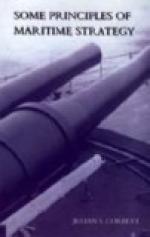If we desire a typical example of the way the old masters used the doctrine of seeking out, it is to be found, not in Nelson’s magnificent chase, but in the restrained boldness of Barham’s orders to Cornwallis and Calder. Their instructions for seeking out Villeneuve were to move out on his two possible lines of approach for such a time and such a distance as would make decisive action almost certain, and at the same time, if contact were missed, would ensure the preservation of the vital defensive positions. Barham was far too astute to play into Napoleon’s hands, and by blindly following his enemy’s lead to be jockeyed into sacrificing the position which his enemy wished to secure. If our maxim be suffered to usurp the place of instructed judgment, the almost inevitable result will be that it will lead us into just the kind of mistake which Barham avoided.
II. BLOCKADE
Under the term blockade we include operations which vary widely in character and in strategical intention. In the first place, blockade may be either naval or commercial. By naval blockade we seek either to prevent an enemy’s armed force leaving port, or to make certain it shall be brought to action before it can carry out the ulterior purpose for which it puts to sea. That armed force may be purely naval, or it may consist wholly or in part of a military expedition. If it be purely naval, then our blockade is a method of securing command. If it be purely military, it is a method of exercising command, and as such will be dealt with when we come to consider defence against invasion. But in so far as military expeditions are normally accompanied by a naval escort, operations to prevent their sailing are not purely concerned with the exercise of command. Naval blockade, therefore, may be regarded for practical purposes as a method of securing command and as a function of battle-squadrons. Commercial blockade, on the other hand, is essentially a method of exercising command, and is mainly an affair of cruisers. Its immediate object is to stop the flow of the enemy’s sea-borne trade, whether carried in his own or neutral bottoms, by denying him the use of trade communications.
From the point of view of the conduct of war, therefore, we have two well-defined categories of blockade, naval and commercial. But our classification must go further; for naval blockade itself is equally varied in intention, and must be subdivided. Strictly speaking, the term implies a desire to close the blockaded port and to prevent the enemy putting to sea. But this was not always the intention. As often as not our wish was that he should put to sea that we might bring him to action, and in order to do this, before he could effect his purpose, we had to watch the port with a fleet more or less closely. For this operation there was no special name. Widely as it differed in object from the other, it was also




